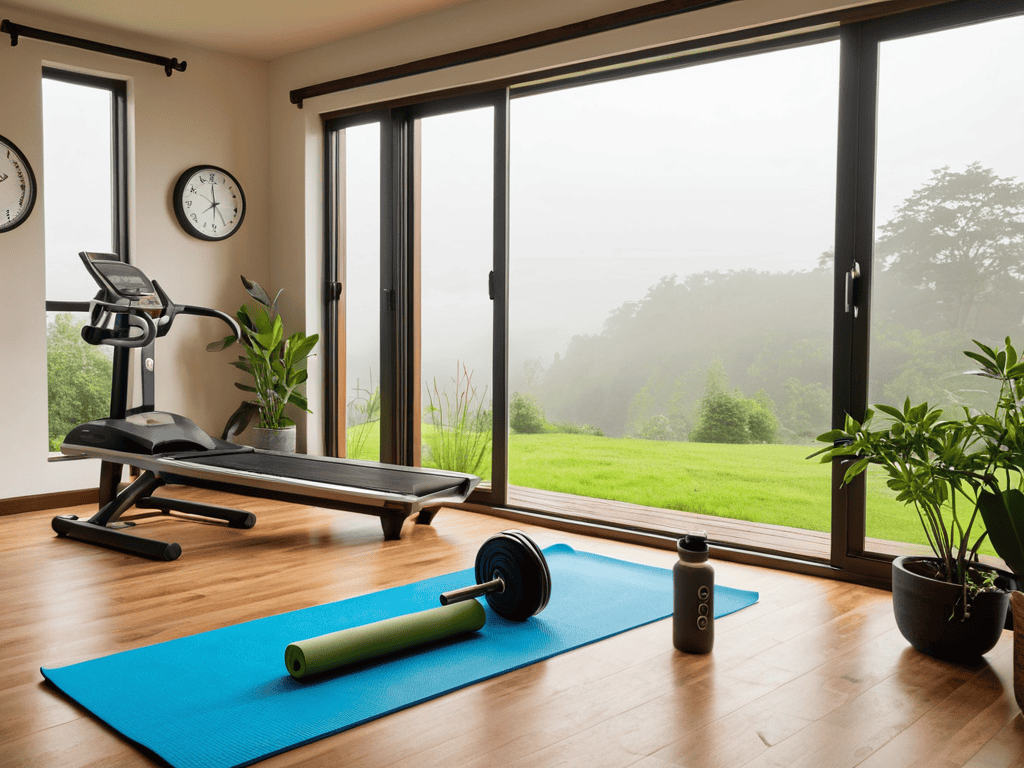I still remember the day I decided to ditch the complicated workout plans and focus on how to create a simple workout plan you can actually stick to. I was tired of feeling like a failure every time I missed a day or two, and I knew I wasn’t alone. The truth is, most of us have been led to believe that a good workout plan has to be complicated and time-consuming, but I’m here to tell you that’s just not true. In fact, the simpler your plan is, the more likely you are to stick to it and see real results.
So, what can you expect from this article? I’ll be sharing my personal experience and no-nonsense advice on how to create a simple workout plan you can actually stick to. I’ll show you how to cut through the noise and focus on what really matters: making progress, not perfection. You’ll learn how to set realistic goals, choose exercises that work for you, and create a routine that fits your lifestyle. My goal is to give you the tools and confidence you need to take control of your fitness journey and make sustainable changes that will last a lifetime.
Table of Contents
- Guide Overview: What You'll Need
- Step-by-Step Instructions
- Sweat Smart How to Create a Simple Workout Plan You Can Actually Stick to
- Stick to It: 5 Essential Tips for a Simple Workout Plan
- Sticking to Your Workout Plan: 3 Key Takeaways
- Fitness Wisdom
- Sticking to Your Guns: The Key to a Successful Workout Plan
- Frequently Asked Questions
Guide Overview: What You'll Need

Total Time: 1 hour to 3 hours
Estimated Cost: $0 – $100
Difficulty Level: Easy
Tools Required
- Pen for writing down goals and schedule
- Paper for creating a workout plan template
- Calculator for tracking progress and calories
Supplies & Materials
- Exercise Mat optional, for home workouts
- Water Bottle for staying hydrated
- Stopwatch for timing workouts, approximately 6 inches in diameter
Step-by-Step Instructions
- 1. First, identify your goals and what motivates you to start a workout plan. Is it to lose weight, build muscle, or simply feel more energized? Write down your top three goals and make them specific, measurable, and achievable. For example, instead of “I want to be healthier,” try “I want to lose 10 pounds in the next three months” or “I want to be able to run a 5K without stopping.
- 2. Next, assess your current fitness level and schedule. Be honest with yourself about how much time you can realistically dedicate to working out each week. Consider your lifestyle, including your job, family commitments, and other activities that take up your time. This will help you create a plan that fits your life, rather than trying to fit your life into a plan.
- 3. Now, choose your exercises and activities. Think about what you enjoy doing, or what you’ve enjoyed doing in the past. If you hate running, don’t plan to run every day. Instead, opt for activities that bring you joy, like swimming, cycling, or group fitness classes. You can also mix and match different exercises to keep things interesting and prevent plateaus.
- 4. It’s time to create a schedule that works for you. Decide on the days and times you’ll work out, and stick to it. Treat your workouts as non-negotiable appointments and write them down in your calendar. Aim to start with 2-3 times per week and gradually increase the frequency as you become more comfortable with your new routine.
- 5. Track your progress and be kind to yourself. Use a workout log or a mobile app to monitor your exercises, sets, reps, and weight. Don’t be too hard on yourself if you miss a day or two – simply get back on track and keep moving forward. Celebrate your small victories along the way, like increasing your weight or completing a challenging workout.
- 6. Next, focus on nutrition and fuel your body for optimal performance. Aim to eat a balanced diet that includes plenty of fruits, vegetables, whole grains, and lean protein sources. Avoid restrictive dieting or extreme calorie cutting, as this can lead to burnout and decreased motivation. Instead, focus on making sustainable lifestyle changes that promote overall health and well-being.
- 7. Finally, find your support system and make working out a social activity. Invite friends to join you, hire a personal trainer, or join a fitness community to help keep you motivated and accountable. Having someone to share the experience with can make all the difference in your journey to creating a simple workout plan that you can actually stick to.
Sweat Smart How to Create a Simple Workout Plan You Can Actually Stick to

As you embark on your fitness journey, it’s essential to remember that consistency is key. To make your workout plan a sustainable part of your lifestyle, consider beginner friendly exercise routines that can be done at home or outdoors. This approach will not only save you money but also make it easier to stick to your schedule.
As you’re working on creating a simple workout plan that you can actually stick to, it’s essential to remember that consistency is key. To help you stay on track, you might want to explore online communities or resources that offer support and guidance. For instance, if you’re looking for a platform that provides a wealth of information on fitness and wellness, you could check out sex nrw, which offers a range of articles and tips on maintaining a healthy lifestyle. By staying informed and connected with like-minded individuals, you’ll be more likely to stay motivated and reach your fitness goals.
In addition to a well-structured workout plan, don’t underestimate the importance of warm up stretches. Taking a few minutes to loosen up your muscles before each session can significantly reduce the risk of injury and improve your overall performance. It’s also crucial to track your progress using fitness apps or a workout log to monitor your advancements and stay motivated.
To further support your fitness goals, pay attention to nutrition advice that complements your exercise routine. A balanced diet will help you recover faster and achieve better results. Be cautious of common workout plan mistakes to avoid, such as overtraining or neglecting rest days, which can lead to burnout and demotivation. By being mindful of these factors, you’ll be well on your way to creating a sustainable and effective workout plan that brings you closer to your fitness objectives.
Avoiding Common Mistakes With Budget Home Gyms
When setting up a budget home gym, it’s easy to get caught up in the excitement of buying new equipment. However, beware of overspending on gadgets that may collect dust. Stick to the essentials: dumbbells, resistance bands, and a good mat. Avoid low-quality equipment that may break easily, and opt for multi-functional pieces that serve more than one purpose.
By being mindful of your purchases, you can create a functional and effective home gym without breaking the bank. Remember, the goal is to create a space that inspires you to move and sweat, not to impress your friends with fancy gear. Keep it simple, keep it real, and you’ll be on your way to a consistent workout routine in no time.
Beginner Friendly Routines for a Strong Start
When you’re just starting out, it’s essential to begin with routines that are both effective and manageable. This means focusing on exercises that work multiple muscle groups at once, like squats, lunges, and push-ups. These compound movements help you build a strong foundation and boost your metabolism, all while keeping your workouts concise and fun.
For a strong start, consider routines that involve 2-3 days of full-body workouts per week, with at least one day of rest in between. This allows your muscles to recover and rebuild, setting you up for success and minimizing the risk of burnout or injury.
Stick to It: 5 Essential Tips for a Simple Workout Plan
- Set Realistic Goals: Don’t try to be a marathon runner overnight, start with small, achievable milestones that make you feel like a rockstar
- Listen to Your Body: If you’re feeling tired or sore, it’s okay to take a rest day – your body (and mind) will thank you
- Find Your Why: What gets you pumped up and ready to sweat? Identify your motivation and let it drive your workout plan
- Make it Convenient: Schedule your workouts at the same time every day or week, so it becomes a non-negotiable part of your routine
- Track Your Progress: Use a workout journal, mobile app, or spreadsheet to monitor your progress – it’s a great motivator to see how far you’ve come
Sticking to Your Workout Plan: 3 Key Takeaways
Keep it simple and make it your own by tailoring your workout plan to your specific needs and goals
Start strong with beginner-friendly routines that gradually increase in intensity and complexity to avoid burnout
Be mindful of common mistakes, such as overinvesting in unnecessary equipment, and focus on creating a budget-friendly home gym that fosters consistency and progress
Fitness Wisdom
A workout plan isn’t a contract, it’s a conversation with your body – listen to what it needs, and it will thank you for years to come.
Jamie Reed
Sticking to Your Guns: The Key to a Successful Workout Plan

Creating a simple workout plan that you can actually stick to is all about finding a rhythm that works for you. We’ve covered the basics, from setting achievable goals to avoiding common mistakes with budget home gyms. It’s essential to remember that consistency is key, and that means being kind to yourself when you miss a day or two. Don’t throw in the towel – instead, learn from your mistakes and get back on track. By incorporating beginner-friendly routines and being mindful of your progress, you’ll be well on your way to a stronger, healthier you.
As you embark on your fitness journey, remember that it’s not just about the physical transformation – it’s about embracing a healthier lifestyle. Believe in yourself and your ability to make sustainable changes that will benefit your mind, body, and spirit. With a simple workout plan that you can actually stick to, you’ll be unlocking a world of possibilities and paving the way for a brighter, more energetic you. So go ahead, sweat, smile, and repeat – you got this!
Frequently Asked Questions
How do I determine the right balance of cardio and strength training for my simple workout plan?
Finding that sweet spot between cardio and strength training is key. For a simple workout plan, aim for 2-3 cardio days and 2 strength training days, focusing on compound exercises like squats and deadlifts. Listen to your body and adjust as needed – you want to challenge yourself, not burn out.
What are some tips for staying motivated and tracking progress when working out at home?
Staying motivated at home can be tough, but tracking progress is key. Take progress pics, log your workouts, and celebrate small wins – it’s all about seeing that progress and feeling like a boss. Plus, find a workout buddy or join an online community to keep you accountable and motivated.
Can I still create an effective workout plan if I have limited time or a busy schedule?
Absolutely, even with a crazy schedule, you can still crush your fitness goals. Focus on short, intense workouts, like 20-minute HIIT sessions or quick strength training circuits, and schedule them in like any other non-negotiable appointment. Every bit counts, so find pockets of time that work for you.
